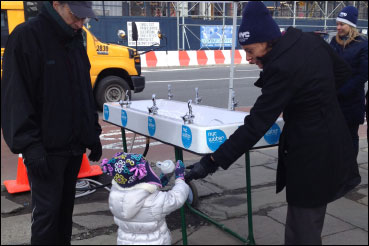 March 22, 2013 CONTACT: Chris Gilbride / Ted Timbers (718) 595-6600 In Celebration of 20th Anniversary of World Water Day Department of Environmental Protection Brings Water-On-the-Go to United NationsOccasion Marks 20 Years of Natural, High-Quality, Unfiltered Drinking Water for More Than Nine Million New YorkersWater-On-the-Go Program Served Award Winning NYC Tap Water to More Than Half a Million Visitors in 2012The New York City Department of Environmental Protection (DEP) today celebrated the 20th anniversary of United Nations (UN) World Water Day by stationing a Water-On-the-Go fountain outside of the UN building, in Manhattan. The fountain will be operated from 7am – 2pm, and visitors will have the opportunity to take a drink and learn about New York City’s water supply system. “In 2012, Water-On-the-Go brought New York City’s refreshing and award-winning drinking water to more than half a million people, saving New Yorkers and visitors alike from extra costs—and pounds—with a free, healthy way to quench their thirst,” said DEP Commissioner Carter Strickland. “World Water Day is a celebration of our most essential natural resource and what better way to celebrate than to share New York City’s award winning tap water with the world.” In addition to recognizing the 20th anniversary of UN World Water Day, DEP also celebrated the twentieth anniversary of the U.S. Environmental Protection Agency’s (EPA) initial issuance of a Filtration Avoidance Determination for the City’s Catskill and Delaware watersheds. In 1993, the EPA determined that New York City’s Catskill and Delaware watersheds were of such high quality they did not require filtration. A 1997 memorandum of agreement allowed the City to move ahead with three key components of its source-water protection strategy: acquisition of vacant land in the watersheds to minimize pollution related to widespread development in areas near reservoirs and other critical source waters; regulatory controls over new development to ensure water protection; and a series of City-funded partnership programs to address existing and potential sources of water pollution. This multi-pronged approach has provided flexibility to address evolving threats such as climate change, and the agility to reallocate resources and adjust to changing conditions. Since then, DEP has invested $1.5 billion in these watershed protection programs that have helped to protect its high quality source waters and allowed the City to supply more than 9 million New Yorkers with high quality drinking water. Today, New York City is one of only five large municipalities in the country with an unfiltered water supply. Throughout the summer months, DEP’s Water-On-the-Go program brings portable drinking fountains to transit hubs, highly trafficked pedestrian areas, and special events throughout the five boroughs to educate New Yorkers about the high quality of the City’s drinking water and to promote environmental stewardship. New York City Water is internationally renowned for its quality and the role it plays in producing, among other things, local bagels and pizza dough. DEP performs daily tests of the city’s drinking water taken from nearly 1,000 sampling locations throughout the five boroughs. This is in addition to the 225,000 tests performed annually throughout the watershed. New York City water is a healthy alternative to sugar-sweetened beverages, containing zero calories, zero sugar, and zero fat. A typical 16-ounce bottle of soda contains about 180 calories and 20 cubes of sugar. Sports drinks, marketed as healthy alternatives, have as many calories as sugary beverages and usually contain high levels of sodium. New York City water is also affordable—at approximately one penny per gallon from the tap, it is approximately 1,000 times less expensive than bottled water. It also helps promote the efforts of PlaNYC, Mayor Bloomberg’s sustainability blueprint for the city; as production of plastic water bottles for use in the United States consumes 1.5 million barrels of oil a year—enough to power 250,000 homes or 100,000 cars for an entire year. The UN has designated March 22nd as World Water Day and recognizes it annually as a means of focusing attention on the importance of freshwater and advocating for the sustainable management of freshwater resources. This year, the UN General Assembly will convene a High-Level Interactive Dialogue that will focus on water related challenges around the world which will require political support and international cooperation. For more information visit: unwater.org/water-cooperation-2013/home/en/. DEP manages New York City’s water supply, providing more than one billion gallons of water each day to more than nine million residents, including eight million in New York City. The water is delivered from a watershed that extends more than 125 miles from the city, comprising 19 reservoirs and three controlled lakes. Approximately 7,000 miles of water mains, tunnels and aqueducts bring water to homes and businesses throughout the five boroughs, and 7,500 miles of sewer lines and 96 pump stations take wastewater to 14 in-city treatment plants. DEP has nearly 6,000 employees, including nearly 1,000 in the upstate watershed. For more information, visit nyc.gov/dep like us on Facebook at facebook.com/nycwater, or follow us on Twitter at twitter.com/nycwater. | ||